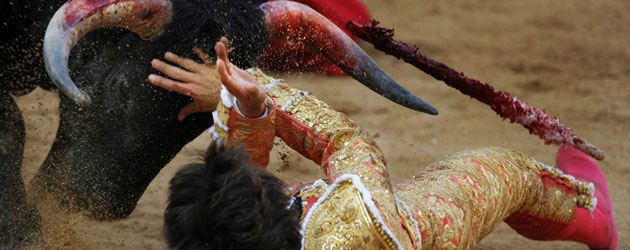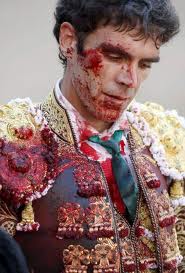Jason Webster is the author of five books on Spain, including Duende, which has been translated into a dozen languages. Or the Bull Kills You is the first in a series of detective novels involving Chief Inspector Max Cámara of the Spanish National Police. The second novel, Some Other Body will be published in UK by Chatto & Windus in February 2012.
Many will be appalled, but bullfighting appears to be back in the public eye: Frank Evans, the OAP matador from Salford, has brought out an autobiography and a programme of his life has appeared on British television; the British film-maker Cat Tosko is making a documentary about bullfighting; while actor and writer Alexander Fiske-Harrison is bringing out a book this May about his experiences learning to fight with some of the best matadors in Spain, Into the Arena.
All this comes at a time when the art-form – and it is viewed as such in Spain; never as a sport – appears to be under threat, not least by the recent Catalan ban, which will come into effect at the end of this year.
So why the sudden interest? Not since the 1960s, and the days of El Cordobés (my grandmother used to call him ‘El Cadawbs’) has bullfighting enjoyed the same level of interest in Britain.
The answer lies in part in what has been happening here in Spain over the past few years.
When in 2007 I started my own book on the subject – Or the Bull Kills You, a detective novel set in my home town of Valencia – bullfighting felt very much to be on the wane. Figures were published around that time showing a steep decline in the number of spectators at fights, while some 60 per cent of Spaniards said they either disliked or weren’t interested in bullfighting. National television, meanwhile, had simply stopped broadcasting bullfights altogether.
To get an idea of how significant this was, it is worth recalling that los toros, as it is called in Spanish, has been regarded for centuries as the ‘national fiesta’, as somehow encapsulating the essence of the country. The poet Federico García Lorca described it as ‘the most civilised fiesta in the world,’ while his contemporary, the philosopher Ortega y Gasset went as far as to say that you couldn’t understand the history of Spain without knowing something about bullfighting.
So a slump in ticket sales, and opinion polls indicating that a majority of the country wasn’t interested in it, was big news. It was even suggested in some quarters that bullfighting might cease to exist in the form that we know it. Certain Catalan politicians had been talking about banning it in their region up to that point, but it was now suggested that the last remaining bullring in Barcelona might simply close due to economic circumstances rather than for any moralistic reasons.
And then something happened which changed everything.
José Tomás (below) had already had a successful career as a matador, but some four or five years before had decided to retire at a young age, much to the disappointment of aficionados. He was viewed as one of the old school, a bullfighter who truly put his life on the line every time he went out to fight, and did so with grace and elegance, unlike many of the matadors of the current circuit. Bullfighting had suffered greatly by his decision to quit.
But one day, just as pundits were predicting the end of los toros, José Tomás announced to the world that he was coming back. And his return fight wouldn’t happen in any old place, it was set to happen at La Monumental, the Barcelona bullring. It was a statement: bullfighting may be threatened, but José Tomás would return, like a messiah, to rescue it, taking the fight to the heart of the enemy camp.
The effect was electrifying. For a while no one talked of anything else. José Tomás appeared on the front pages of the national newspapers, while tickets for the fight sold out in minutes, many later passing hands on the black market for thousands of euros.
And the fight didn’t disappoint. José Tomás triumphed in Barcelona, and was carried out on shoulder-back, a hero.
Not surprisingly, this angered the antitaurino section of Catalan society even more. Partly in response to José Tomás’s return to the ring, a popular petition against bullfighting was launched, which eventually led to the ban.
The Catalan move itself, however, then brought on a knock-on effect in much of the rest of the country: Madrid and Valencia were swift in declaring bullfighting a protected cultural asset – not really worth very much but an act of defiance nonetheless. Meanwhile a petition has been started in Andalusia by the Green Party to attempt something similar to Catalonia. It isn’t expected to get very far, but it’s a sign of the times that it is even happening.
Spanish politics and society can appear quite polarised to British eyes: here Right and Left mean something that they haven’t really done in the UK since the early Thatcher years. Bullfighting, however, had somehow escaped this tendency: it was in decline; no one bothered too much about it.
All that has changed: the debate is now very much more in terms of ‘for’ or ‘against’. Paradoxically, the Catalan ban has probably ensured the chances of bullfighting surviving relatively unscathed for at least the next twenty years.
José Tomás almost certainly won’t be with us for that long – at least not in the ring. Yet his legacy seems already established: a new generation of bullfighters are working their way up, inspired by the monster-slaying heroism of this enigmatic, immensely important figure. From decadent decline, bullfighting is passing once again through something of a golden period.
Can any of this be communicated to a British audience? Perhaps, but it isn’t easy. The British prefer death to be served as a side-dish, preferably one that can be dined on in private. Bullfighting comes from a culture that eats death for breakfast, lunch and dinner, because it understands that without death there is no life.
As the contemporary philosopher Fernando Savater says: ‘Yes, there is death in a bullfight, but as an ally, as an accomplice to life; death has a walk-on part so that life can be affirmed.’













Jason, interesting post which I agree with. In an apparent contradiction, the profile raising by the anti-taurinos causes the spectacle to reinvigorate. However, the called me an old cynic, but that then means that they have a nice, clear and long-lived flagship issue (or sole reason to exist for single-issue groups like CAS International) to raise funding with. One has to make a living somehow. As to the actual cruelties or not, please do take a look at the post ‘The Rights and Wrongs of Bullfighting’ on my blog, linked above. No one can claim neutrality on this, but I do at least try to be impartial… Xander
very interesting post – I had a spanish girlfriend whose father watched hours of bullfighting every night, which was my introduction to the sport. Personally I’m not that excited by watching animals getting killed, but I’m no particular advocate of banning it – besides, can we brits really claim moral superiority over the spanish after the 2 horse deaths at Aintree on Saturday?
Well, anything that gets up the nose of the Catalans must be all right. I spent three years of my life spending every other weekend in Barcelona and their conceit – mostly based on comparing themselves favourably to what they considered to be the Castillian peasants of ‘Spain – was ridiculous.
I got into bullfighting at the same time and probably for related reasons; even going so far as becoming a member of the Club Taurino de Londres. I saw some amazing corridas, the best being in El Puerto de Santamaria with El Juli and Jose Tomas on the bill, but my enthusiasm took a severe dent at a terrible and disorganised corrida in Carcassone, France. The Fiesta Nacional has taken a dent in Spain, but has also been expanding rapidly in France. Unfortunately the French haven’t got the same artistic relationship to death as the French.
Evans of course may argue that chasing an already half dead animal around a dusty arena and then triumphantly sticking a sharp sword through its heart is little different to Salford’s rapidly emptying bingo halls of a fine sunny Friday evening.
Fun fact: one of the most famous British aficiendos of bullfighting is Sir Bobby Charlton. The influence of 1950s Madrid, presumably, or else Ernest Hemingway, for whom he has expressed enthusiasm.
In the second volume of his autobiography ‘My England Years’, Charlton identifies a tour of the Americas in 1959 as the starting point of his love of bullfighting. Following an England defeat to a ‘much inferior Mexico team’, he had been moping in his hotel room in Mexico City when someone asked: ‘does anyone want to see a bullfight?’ They went to the Plaza de Toros and he was immediately smitten. He writes with great enthusiasm for bullfighting, emphasising his tremendous respect for the courage of the vulnerable matador, with a relatively lightweight acknowledgement of the cruelty inflicted on ‘the great beast’. He then ‘devoured’, in his new-found enthusiam, Hemingway’s Death in the Afternoon, in which the author states that ‘everything depends on your emotional response, whether you identify with the man or the animal.’ Bobby leaves absolutely no doubt he identifies with the matador.
Can’t help thinking what a fantastic television play that story would make, John. The post-Munich 50s – Charlton – Mexico City as it was then – bullfighting – books – football. Bend history so that he meets his wife amongst the spectators and it’s complete!
I love the idea, James; the mix of ingredients you mention would be intoxicating. Who plays the young Bobby? The actor needs a full head of hair – no comb-overs necessary in ’59. The accent of a 21 year old from Ashington would be a challenge. The closest I can get is Cheryl Cole. She’d want the part, but I can see problems when she’s required to belt 80 yard passes over the Mexican defence.
You’re right. It’ll have to be Natalie Portman, then.
just checked out ‘or the bull kills you’ on amazon and it looks really good, have bought a copy for my wife who likes murdery thrillery books
Worm, it’s being billed as the Aurelio Zen of Spain, which is a very high recommendation in my book. I’ve earmarked it for some beach reading.
By the way, I searched Amazon for images of José Tomás and found some astonishing shots, including the two used in the post. Well worth a look:
http://www.google.co.uk/search?q=jose+tomas+images&hl=en&rlz=1G1GGLQ_ENUK261&prmd=ivnso&tbm=isch&tbo=u&source=univ&sa=X&ei=W2ijTZDIApKZhQfsoZSNBQ&ved=0CBoQsAQ&biw=1144&bih=622
See also this interview (in the April issue of Guernica magazine) with an American bullfighter; interview’s focus is the ban in Catalonia:
http://www.guernicamag.com/interviews/2531/ford_4_1_11/
From my interviews recently with the boys and girls coming up to the novadillas in Malaga for example, this is not a dying art but a flourishing part of a social calendar in Andalucia, driven on by the age of celebrity and digital media, which reports on Cayetano and Fandi alongside Shakira and Rio Ferdinand. Jose Tomas portrays the celebrity they want to be – exciting, dramatic and rather good to look at, and of course much more accessible to them as a role model than any Hollywood figure.